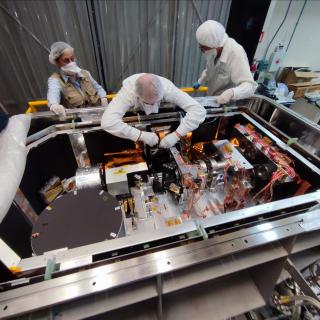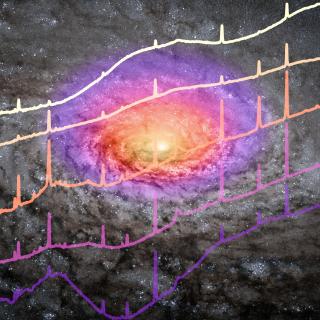Los resultados de Planck , lanzado en mayo de 2009, son fruto del trabajo de más de 300 investigadores internacionales, con la participación de varios científicos del IAC.
El satélite Planck de la Agencia Espacial Europea (ESA, en su acrónimo inglés) comienza a ofrecer resultados, algo más de un año después de su lanzamiento. Los nuevos datos, fruto de la colaboración internacional de más de 300 investigadores que incluye a científicos del Instituto de Astrofísica de Canarias (IAC), incluyen información de relevancia sobre la radiación de microondas emitida por el Big Bang, la Vía Láctea y otras galaxias. Asimismo, el satélite ha detectado nuevas regiones donde se formarán estrellas, numerosos cúmulos de galaxias y una intrigante emisión de microondas anómala. Los resultados han sido presentados hoy en conferencia de prensa en París.
Planck, lanzado el 14 de mayo de 2009, ha realizado dos exploraciones completas de todo el cielo. En su periplo, según explican sus responsables, ha analizado el espectro de la radiación cósmica de microondas o radiación de fondo cósmica. Estas emisiones de energía, presentes por todo el universo, se consideran la principal prueba del modelo que explica el origen del Universo a través de la explosión del Big Bang. Los análisis del satélite de la ESA en este ámbito han permitido identificar nuevas fuentes de emisión de microondas, tanto en la Vía Láctea como en otras múltiples partes del Universo.
El satélite también ha obtenido las medidas más precisas disponibles sobre la acumulación de emisión infrarroja producida por todas las galaxias formadas a lo largo de la historia del Universo, lo que se conoce como el Fondo Cósmico Infrarrojo. El estudio de esta radiación permitirá entender mejor la conexión entre materia luminosa y materia oscura, aquella que no emite suficiente radiación para ser observada directamente pero cuya existencia puede inferirse a partir de los efectos gravitacionales que causa en la materia visible, como las estrellas.
Asimismo, el satélite de la ESA ha podido localizar nuevos núcleos densos y fríos de gas molecular. Estas nubes de gas son regiones que, tras colapsar, darán lugar a nuevas estrellas en el Universo. Las observaciones de Planck han permitido trazar un nuevo catálogo de estas nubes que incluye alguna de las más frías detectadas hasta la fecha. La mayor parte de ellas se ha identificado en el plano central de la galaxia, pero también se han detectado en regiones alejadas.
Cúmulos de galaxias y una emisión anómala
Por otro lado, el trabajo de Planck ha permitido certificar la existencia de más de 180 cúmulos de galaxias, un tipo de estructura cósmica formada por cientos o miles de galaxias. El hallazgo ha sido posible gracias al efecto Sunyaev-Zeldovich, un fenómeno de interacción de alta energía de la radiación de microondas con los electrones libres del medio interno del cúmulo. “Muchos de estos cúmulos ya eran conocidos, pero algunos han sido identificados por primera vez por su señal en microondas y confirmados con observaciones ópticas que hemos realizado en el telescopio IAC80 del Observatorio del Teide” afirma José Alberto Rubiño, investigador Ramón y Cajal del IAC y científico del consorcio Planck.
Uno de los resultados más destacados del satélite Planck es la detección de una intrigante emisión anómala de microondas en varias regiones de la Vía Láctea, entre ellas el complejo de formación estelar de Perseo, uno de los más cercanos al Sol. Las observaciones de Planck confirman la existencia del este particular fenómeno, detectado por primera vez hace cinco años por el experimento español COSMOSOMAS. “Ahora, tenemos la enorme satisfacción de ver cómo las medidas del satélite Planck confirman rotundamente lo que descubrimos con nuestro sencillo experimento desde el Observatorio del Teide” afirma Rafael Rebolo, co-investigador del satélite Planck y profesor de Investigación del CSIC en el IAC, que dirigió el experimento COSMOSOMAS.
¿Qué provoca esta emisión anómala? Su origen se atribuye a moléculas carbonáceas que girarían en el medio interestelar a razón de miles de millones de vueltas por segundo produciendo emisión dipolar eléctrica. Las medidas del satélite despejan cualquier duda sobre la existencia de esta emisión anómala, pero queda por establecer su naturaleza definitiva.
El IAC ha contribuido a la misión Planck con varias aportaciones. Entre ellas, cabe destacar el REBA (Radiometer Electonics Box) del instrumento LFI (Low Frequency Instrument). El IAC es responsable del desarrollo de su hardware, en colaboración con la empresa española CRISA, así como del software de control y procesado de datos, ideado íntegramente por el equipo de ingeniería de software del IAC.
Más información, vídeos e imágenes sobre el satélite Planck, en el siguiente enlace:
http://www.esa.int/esaSC/120398_index_0_m.html
Contacto:
Rafael Rebolo; rrl [at] iac.es (rrl[at]iac[dot]es); 922 605 273 / 922 605 200


